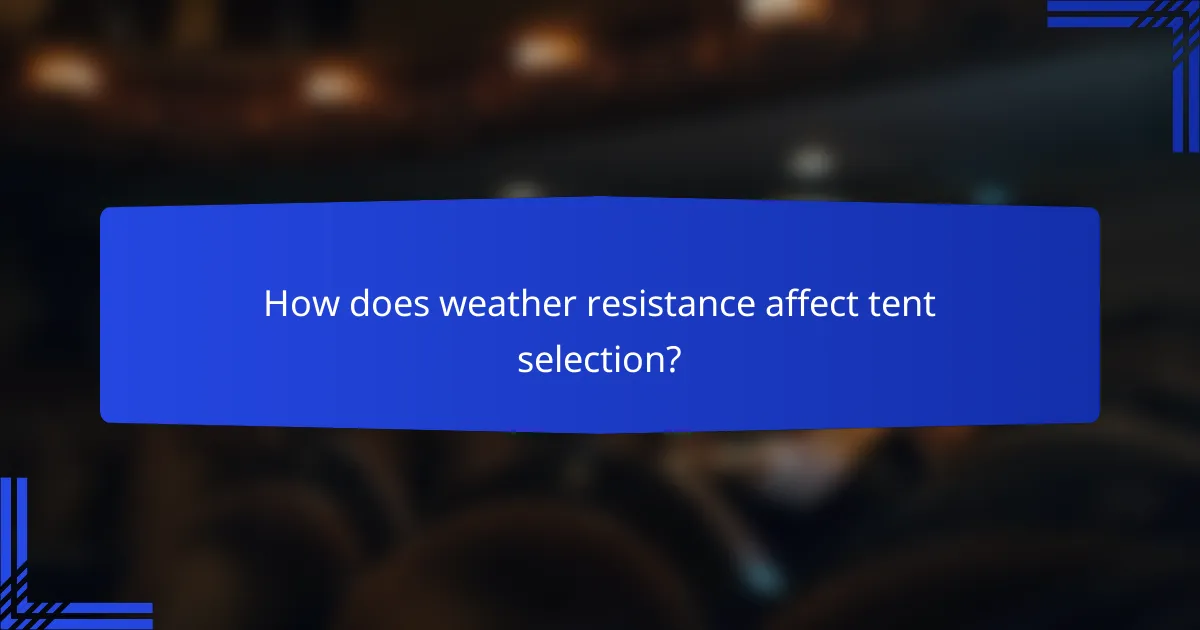When selecting a camping tent, it’s essential to consider size, weight, and weather resistance to ensure a comfortable and safe outdoor experience. Tents should be spacious enough for occupants and gear while remaining lightweight for easy transport. Additionally, prioritize models with strong weather resistance to handle unpredictable conditions, particularly in regions like New Zealand.

What are the best camping tents for New Zealand weather?
The best camping tents for New Zealand weather are those that offer excellent weather resistance, lightweight designs, and appropriate sizes for various group needs. Look for tents with good waterproof ratings and sturdy construction to withstand the region’s variable climate.
MSR Hubba NX 2
The MSR Hubba NX 2 is a popular choice for its balance of weight and durability. Weighing around 1.7 kg, it’s lightweight enough for backpacking while providing ample space for two people. Its rainfly and floor are made from high-quality materials, ensuring reliable weather resistance in New Zealand’s often unpredictable conditions.
This tent features a unique hub-and-pole system that allows for quick setup and takedown, making it ideal for campers who need to move frequently. Additionally, the tent’s cross-ventilation design helps reduce condensation, which is particularly useful in humid environments.
Big Agnes Copper Spur HV UL2
The Big Agnes Copper Spur HV UL2 is another excellent option, known for its ultralight design and spacious interior. Weighing approximately 1.42 kg, it is one of the lightest two-person tents available, making it perfect for long hikes in New Zealand’s diverse landscapes.
This tent features a high-volume pole architecture that maximizes living space while maintaining stability. Its waterproof fly and floor provide reliable protection against rain, while the multiple doors and vestibules enhance accessibility and gear storage.
Sea to Summit Telos TR2
The Sea to Summit Telos TR2 stands out for its innovative design and versatility. Weighing around 1.6 kg, it offers a good balance between weight and livability, making it suitable for both casual campers and serious backpackers in New Zealand.

How do I choose the right tent size?
Choosing the right tent size depends on the number of occupants and the intended use. Consider how much space you need for sleeping, gear storage, and comfort, as well as the weight and portability of the tent for your camping style.
Two-person tents for couples
Two-person tents are ideal for couples seeking a cozy camping experience. They typically offer enough space for two sleeping bags and some personal gear, making them lightweight and easy to carry.
When selecting a two-person tent, look for models with a minimum floor area of around 30 square feet. Consider features like vestibules for gear storage and good ventilation to enhance comfort during your trip.
Four-person tents for families
Four-person tents are designed for small families or groups, providing ample space for sleeping and gear. These tents usually have a floor area of about 60 square feet, allowing for more room to move around and store belongings.
When choosing a four-person tent, prioritize features such as easy setup, multiple entrances, and good weather resistance. Ensure that the tent can comfortably accommodate your family, especially if you plan to spend extended time inside during inclement weather.

What is the ideal weight for camping tents?
The ideal weight for camping tents varies based on the type of camping and the number of occupants, typically ranging from under 2 kg for lightweight options to around 4 kg for standard models. Choosing the right weight involves balancing portability with durability and space requirements.
Lightweight options under 2 kg
Lightweight camping tents, weighing under 2 kg, are designed for backpackers and those who prioritize portability. These tents often use advanced materials like nylon and lightweight poles, making them easy to carry over long distances.
When selecting a lightweight tent, consider its weather resistance and space. While they are easier to transport, they may sacrifice some durability and comfort, so ensure they meet your specific camping needs.
Standard options between 2-4 kg
Standard camping tents, weighing between 2-4 kg, offer a balance between weight and comfort, making them suitable for car camping or short hikes. These tents typically provide more space and better weather protection, accommodating more gear and occupants.
When choosing a standard tent, look for features like sturdier materials, better ventilation, and additional storage options. While they are heavier than lightweight models, they often enhance the overall camping experience by providing more comfort and stability in various weather conditions.

How does weather resistance affect tent selection?
Weather resistance is crucial in tent selection as it determines how well a tent can withstand rain, wind, and temperature variations. Choosing a tent with appropriate weather resistance ensures comfort and safety during outdoor adventures.
Waterproof ratings explained
Waterproof ratings indicate a tent’s ability to resist water penetration, typically measured in millimeters (mm) of water column pressure. A rating of 1,500 mm is generally suitable for light rain, while 3,000 mm or higher is recommended for heavy rain and wet conditions.
It’s essential to consider the tent’s fabric and seams, as these factors also influence waterproof performance. Tents with sealed seams and high-quality materials provide better protection against leaks.
Seasonal tents for extreme conditions
Seasonal tents are designed for specific weather conditions, with three-season tents suitable for spring, summer, and fall, while four-season tents can handle winter conditions. Four-season tents are typically sturdier, featuring stronger poles and more robust materials to withstand heavy snow and strong winds.
When selecting a tent for extreme conditions, prioritize features like wind resistance, ventilation, and insulation. For example, a tent with a low profile and a sturdy structure will perform better in high winds, while good ventilation is crucial to prevent condensation buildup in colder temperatures.

What are the key features to look for in camping tents?
When selecting a camping tent, prioritize size, weight, and weather resistance. These features significantly impact comfort, portability, and durability during outdoor adventures.
Ventilation systems
A good ventilation system is crucial for maintaining airflow and reducing condensation inside the tent. Look for tents with mesh panels and adjustable vents that allow for air circulation while keeping insects out.
Consider tents with dual entrances or vestibules, as they enhance airflow and provide additional space for gear. This can be particularly beneficial in warmer climates or during summer camping trips.
Setup ease and speed
Choose a tent that is easy to set up, especially if you plan to camp frequently or in varying conditions. Tents with color-coded poles and simple clip systems can be pitched quickly, often in under 10 minutes.
Pop-up tents are an excellent option for those seeking rapid deployment, while traditional tents may require more time and practice. Always check for included instructions and practice setup at home before heading out.

What are the best materials for camping tents?
The best materials for camping tents typically include nylon, polyester, and silicone-coated fabrics. These materials are chosen for their durability, weather resistance, and lightweight properties, making them suitable for various camping conditions.
Nylon vs. polyester
Nylon and polyester are the two most common fabrics used in camping tents, each with distinct advantages. Nylon is generally lighter and stronger, making it ideal for backpacking tents where weight is a concern. However, it can absorb water, which may lead to increased weight when wet.
Polyester, on the other hand, is more UV-resistant and does not stretch as much when wet, maintaining its shape better in rainy conditions. While it may be slightly heavier than nylon, it often comes at a lower price point, making it a popular choice for family camping tents.
Silicone-coated fabrics
Silicone-coated fabrics are increasingly popular for high-performance camping tents due to their excellent waterproofing and durability. These fabrics are typically made from nylon or polyester and are coated with silicone to enhance their resistance to water and UV rays.
While silicone-coated tents can be more expensive, they often provide superior weather protection and longevity. When choosing a tent with silicone-coated fabric, consider factors like weight and packability, especially if you plan to hike long distances.

How do I maintain my camping tent?
To maintain your camping tent, regularly clean it and store it properly to prolong its lifespan. Proper care helps prevent mold, mildew, and damage from environmental factors.
Cleaning tips
Start by removing any dirt or debris from the tent’s surface using a soft brush or cloth. For deeper cleaning, use a mild soap mixed with water and a sponge, avoiding harsh chemicals that can damage the fabric.
After washing, rinse the tent thoroughly to remove all soap residue. Allow it to air dry completely before packing it away to prevent mold growth.
Storage recommendations
Store your tent in a cool, dry place, ideally in a breathable storage bag rather than the compression sack used during travel. This helps maintain the tent’s shape and prevents moisture buildup.
Avoid storing the tent in direct sunlight for extended periods, as UV rays can degrade the fabric. Check the tent periodically for signs of wear or damage, addressing any issues promptly to ensure its readiness for your next camping trip.
